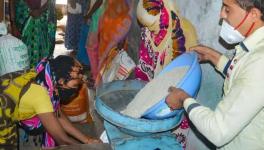Looming Danger: Uncontrolled COVID Spread in High Population States
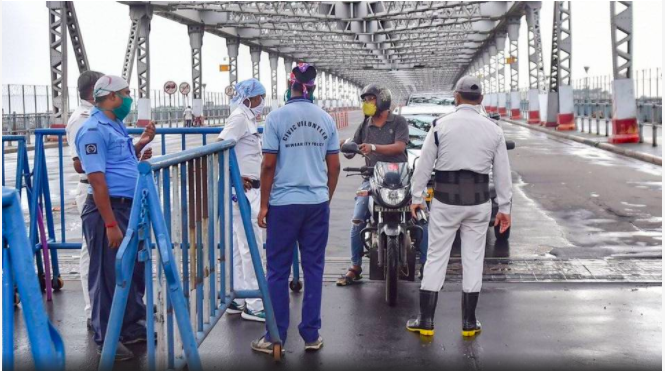
The Indian people are gazing into an abyss and – as famously said in another context – the abyss is gazing back into them. The pandemic has already well and truly gripped the country with nearly 17 lakh cases, and around 50,000 new cases getting added every day. Deaths have crossed the 36,000 mark. But this is far from the depth to which this deadly virus is likely to go.
A state by state analysis of COVID-19 cases in the past two months shows the pandemic is clearly surging in many of them, and can potentially surge in several others. Put together, about 60% of the country’s population lives in these states, which are mostly poor, less urbanised, with poor health indicators, and poorer healthcare infrastructure. Penetration of COVID in this vast hinterland is a distinct possibility.
States Which Currently Have Two-Thirds of Cases
To understand why, let’s start with the six states which together host just over two-third of all COVID cases in India. These are: Maharashtra, Andhra Pradesh, Tamil Nadu, Karnataka, Uttar Pradesh and Delhi. The chart below (data from health ministry) shows the trajectory of new cases (added up weekly) for the past two months, June and July. Since these are the states with the bulk of cases, it is necessary to assess where the pandemic is heading in them.
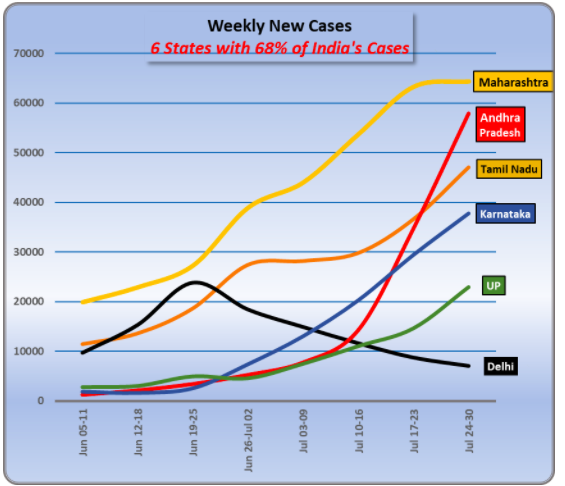
The most striking thing is that cases have risen very sharply – exponentially, if you will – in Andhra Pradesh. Two months ago, this state was not on the radar – now it is a hotspot. Earlier, preventive measures may have had some effect or kharif sowing may have brought people together, catalysing more transmission. It is unclear, but the rise is staggering.
Tamil Nadu seemed to have controlled the disease, as can be seen in the flattened curve in the first fortnight of July, but after that, the cases have inexorably risen. Maharashtra, leading all the states in the number of cases since long, appears to have reached a plateau in the last week of July. This hides the fact that virus infections are spreading to smaller towns and some rural areas, even if decelerating in Mumbai and Pune, the earlier hotspots.
While in UP and Karnataka, COVID cases continue a steady rise. Delhi is the only place where weekly new cases have come down notably. Delhi has, of course, received much attention, and has far better resources to deal with the pandemic. So, it is unsurprising that, down the line, cases and spread have been restricted.
But, the UP situation is dangerous because it is India’s most populous state with a population of nearly 23 crore, and the danger of widespread transmission is clear and present. The Bharatiya Janata Party government led by Yogi Adityanath, which was getting applauded for the low number of cases earlier, is now going to be tested for its announced preparations to meet the pandemic.
States on the Brink
Now take a look at the next bunch of states which have about 20% of all cases in India, as of now. As shown in the chart below, Bihar stands out for its explosive rise in cases since July. Only the returning migrants can’t be blamed for this. It’s also low testing and the collapse of tracing, isolation/quarantine measures. There are hair-raising stories about hospitals. And amidst all this, there have been heavy rains, and consequent floods in some parts. Whatever the reasons, Bihar, with its over 12 crore population, is on the brink of seeing a continuing surge, unless effective interventions are made by the Nitish Kumar-led National Democratic Alliance government.
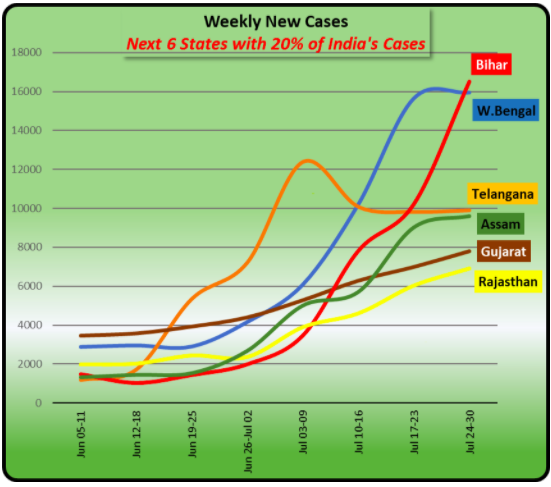
Telangana showed a huge rise in cases in early July, but since then the pandemic seems to have plateaued – assuming that the numbers are accurate. West Bengal and Assam, too, appear to have reached a peak and are showing a flattening of the curve in the last week of July.
But, all this can vanish within days, as we have seen in other states. Going by the record of other states, the risk of new clusters developing and cases again rising in these states is very high. But there doesn’t seem to be any strategic option before the governments, either in states or at the Centre. The only option they seem to have chosen is lockdowns (of various degrees).
States Where Potential Surge Possible
All the rest of the states put together make up just about 12% of the total cases in India. Most of these states are too small to make any impact on aggregate numbers but for the people of the state, it’s a matter of life and death. Cases are rising in most of them, including the North-East.
But included in this last bunch of states are a group of relatively bigger states, such as Madhya Pradesh, Odisha, Chhattisgarh and Jharkhand. [See chart below] All have hefty tribal populations and large forested areas. They are all very backward. They have been spared the devastation of the pandemic till now but that’s as much due to relative isolation and terrain as to government policy.
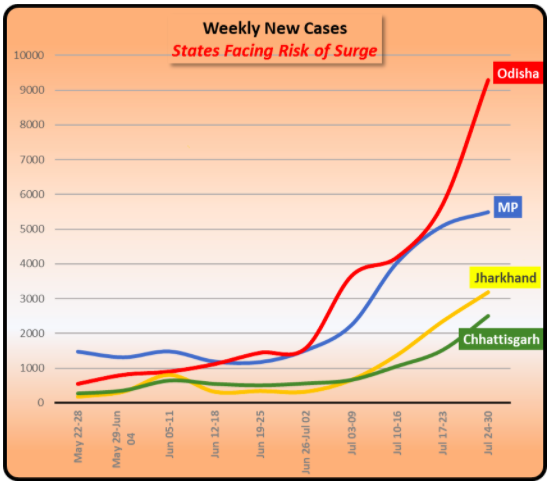
Odisha has, in the recent weeks, shown a sudden spurt of cases after having successfully restricted the virus transmission for all these months. So, there is a clear danger in that coastal state, with a threat for nearby Chhattisgarh and Jharkhand too.
Madhya Pradesh, too, has remained one of the states with low transmission but again in recent weeks cases have increased significantly. These are states with huge populations and a shaky policy on controlling the pandemic, due to poor health infrastructure. The coming weeks will be crucial to assess the pandemic’s trajectory in these regions.
Central Government: Flatters to Deceive
In sum, COVID is showing signs of spreading in some of the most populous regions of India and if quick measures are not taken, it will acquire a disastrous dimension because most of these states are cash-strapped, have poor health infrastructure and, unfortunately, don’t inspire much confidence in terms of prevention or mitigation of pandemic.
The role of the Central government in this situation is crucial, but again, sadly, it has shown itself in very poor light. While it seized the opportunity to concentrate power through the Disaster Management Act and wielded it rather ham-handedly in imposing a misconceived and premature countrywide lockdown in March, at the current stage it has left the battle almost entirely to state governments, and confined itself to issuing various guidelines centred around lifting restrictions.
The Centre has not helped the states with sufficient funds to carry out the battle on the ground. In fact, it has not even provided the funds owed to states statutorily, like Goods and Services Tax or GST compensation. In fact, at this time, when more coordinated efforts are needed and more fiscal muscle needs to be provided, the Centre has suddenly disappeared. This, too, doesn’t augur well for the coming weeks, when there is a high risk of the disease surging in highly populated and poorer states.
[Peeyush Sharma and Newsclick’s Data Analytics Team collated the data]
Get the latest reports & analysis with people's perspective on Protests, movements & deep analytical videos, discussions of the current affairs in your Telegram app. Subscribe to NewsClick's Telegram channel & get Real-Time updates on stories, as they get published on our website.














